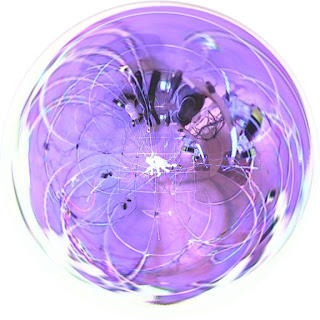
Construction of a conical mirror anamorphosis by Fernandino Galli da Bibena. 1731.
The next steps of this project are twofold:
1. To submit a succinct thesis proposal that will guide my next four months of work.
2. To create a theatre for Homunculus.
This thesis is a design led investigation into the process of finding/making enchanted space. Enchantment is proposed as a means of describing an indeterminate and evolving state of interaction, where poetic meaning of the environment, contains the possibility for "complex, layered interpretation, even the kind of interpretation that surprises the person interpreting". It is this thrill and surprise, by which an artefact or environment is experienced, that becomes measure of the engagement with which we explore our surroundings.
My thesis takes point of departure from an analysis of the conceptualization of space and place in the grotesque, and from the work Hylozoic Soil by architect Phillip Beasley, 2007. A field of reference is also provided by Homunculus, a work I created for the Dedale studio “DeMonster Monster” project instructed by Patrick Harrop and installed in Hexagram’s Black box at Concordia University in November 2007.
Homunculus begins a discourse on puppets and other human simulacra. Even as conventional puppet shows retain timeless theatrical charm and unique architectural circumstance, the autonomous puppet moving without master carries a far stronger charge of the "uncanny". Within this world of the occult, pseudo sciences (such as alchemy) merged with developments in natural science to create within the grotto an illusory realm; it is this place that Homunculus calls home. Homunculus is a performer, a marionette suspended by string from a series of servo motors. The motors are controlled by a sync disc that has been created through a copper etching process. Homunculus has parallels in the story of Daedalus, who uses quicksilver to install a voice in his statues; and of Greek god Hephaestus who created the automata, Talos, an artificial man of bronze, for his workshop. The simulacrum has always traveled both a high road and a low road in human culture— "as highest form of worship and as lowest form of entertainment—but it is a peculiarity of Western culture of the last three hundred years that the two roads have joined into one that runs, as it were, underground" (Nelson, 60)
The theatre for Homunculus is a place of inhabitation and interaction, an "illusory realm" rooted in the grotesque. Like the grotto, the theatre recalls enchanted space-- a space that must be active and elastic. The theatre will reflect an architecture that controls our understanding of the performance. Creating this realm will be the focus of my next week of intensive work.
SOME DIRECTIONS:
The Brothers Quay have been highly successful in collapsing the relationship between figure and ground. The Cabinet of Jan Svankmajer and Anamorphosis reflect nightmarish environments that function as both agent and actor . Stylistic and spatial novelty-- achieved through differing scales, perspectives and gravities, evoke complex and meaningful relationships between creature and composition. The use of anamorphic perspective is of particular techtonic interest. Drawing in this way creates nonsensical forms and misleading diversions suggesting an illusory architecture.
















































